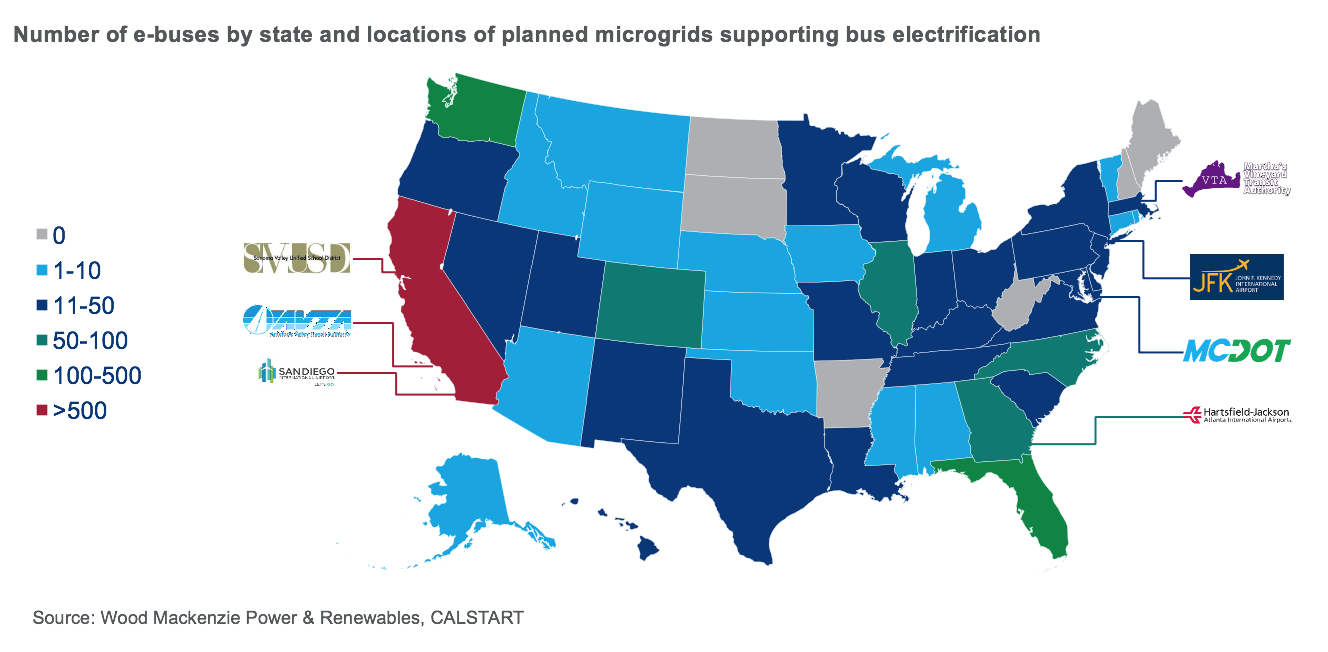与我们分析师联系
Lessons from the first 100 percent battery-electric bus fleet in the US
A transit agency that is turning to a microgrid and electric buses is an instructive case study for other agencies
1 minute read
The Antelope Valley Transit Authority in Southern California plans to be the first public transit agency in the United States to operate a 100 percent battery-electric bus fleet.
Today AVTA operates 49 e-buses from Chinese bus manufacturer BYD, with 36 more e-buses to be delivered by the end of 2020, allowing the agency to meet its zero-emission fleet target. AVTA is also planning to install a microgrid at its bus depot.
We forecast that electric drivetrains will grow from 3 percent to 9 percent of the annual bus market by 2025, with their share increasing to 30 percent in the bus transit submarket.
E-bus penetration is on the rise, and our case study outlines how AVTA’s e-bus transition and microgrid journey illustrates four lessons that can inform other agencies.
1. Electrification done well can lead to significant savings
AVTA’s purchase of electric buses from BYD is forecast to cost $78.6 million and be completed in 2022.
The purchase of e-buses made up most of the total electrification costs, with charging infrastructure contributing an estimated 15 percent.

Operational costs were also a key consideration in AVTA’s e-bus electrification.
The agency projected that increased electricity consumption for charging buses would be offset by savings from decreasing the use of diesel and lower maintenance costs.
When the agency completed the first million miles of electric bus operation, it determined it had saved $500,000 compared to operating diesel buses.
2. Depot charging alone may not be sufficient
AVTA expects that 80 percent of its e-bus charging will occur at the bus depots. The agency has also deployed five wireless charging stations along some bus routes to augment depot charging.
AVTA found that some routes would be benefit from additional charging beyond the depot. Wireless charging was chosen at these sites over pantograph charging, the other main form on on-route charging, due to safety concerns.
So far, charging at the depot has been the most widespread form of e-bus charging in the U.S., though on-route charging such as overhead (pantograph) and wireless charging are becoming more common.
While depot charging is less expensive than on-route charging at approximately $100,000/charger, depot charging requires the bus to be plugged into the charger for hours at a time, complicating bus operations.
3. Coordinated charging has a learning curve
The learning curve for managing charging was one of the biggest hurdles AVTA faced in its fleet-electrification journey.
AVTA started out using spreadsheets to determine when specific buses should be charged. As its e-bus fleet grew, AVTA turned to an outside supplier of integrated control and monitoring solutions for transit to develop an e-bus load management system.
In general, if the grid that serves a bus depot cannot physically support the increased electric demand for charging buses, upgrades to substations and distribution lines will be required. This can drastically impact a project’s economics.
For example, AVTA found that it cannot simultaneously charge 90 buses given the current grid infrastructure in its jurisdiction. As a result, the agency developed a charging protocol to charge buses in waves based on variables such as the state of charge of each bus and route optimization, allowing for the complete electrification of the fleet while operating within the constraints of the grid.
Situations like this present a clear opportunity for utilities to provide insight into the capacity of the grid and strategies to coordinate charging infrastructure within those constraints.
4. Microgrids can provide additional savings
Of 202 transit agencies in the U.S. that have e-buses, AVTA is one of only seven that are planning a microgrid. The agency is integrating this solution to achieve cost savings, resilience and sustainability goals.
AVTA released a request for proposals for solar and storage systems that would cover its extra electricity needs stemming from e-bus charging. The selected energy partner will own the solar and behind-the-meter storage assets and sell the energy to AVTA via a 25-year contract with guaranteed savings.
AVTA followed a pattern similar to other transit agencies: Microgrids and other distributed energy resources are not often considered until after transit authority has gained experience with its first electric buses. Microgrid players may want to begin conversations with agencies during this key window after their first e-bus purchases, when potential customers are likely to be most open to learning about solutions.
As e-buses claim a larger share of U.S. bus sales, the opportunity around fleet electrification grows. Fleet operators, utilities and microgrid developers are just beginning to explore the opportunities and benefits at the nexus of e-buses and distributed energy resources.
The full insight, Electric Bus Charging Infrastructure and Microgrids: A Grid Edge Case Study, is available for purchase.
The insight is authored by Kelly McCoy, an electric vehicle analyst at Wood Mackenzie, and Isaac-Maze Rothstein, a microgrid analyst.